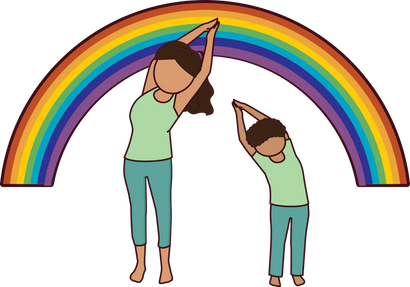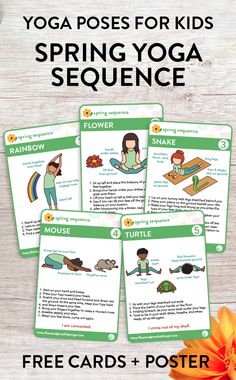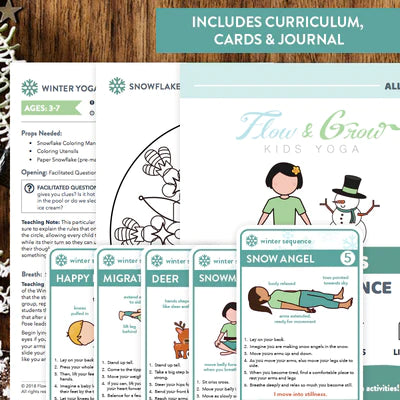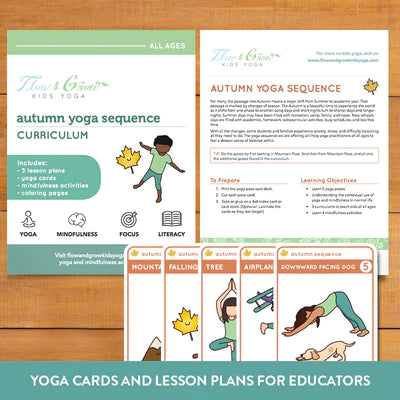Your Cart is Empty
22% off Automatically at checkout when you spend $5 of more!
22% off Automatically at checkout when you spend $5 of more!
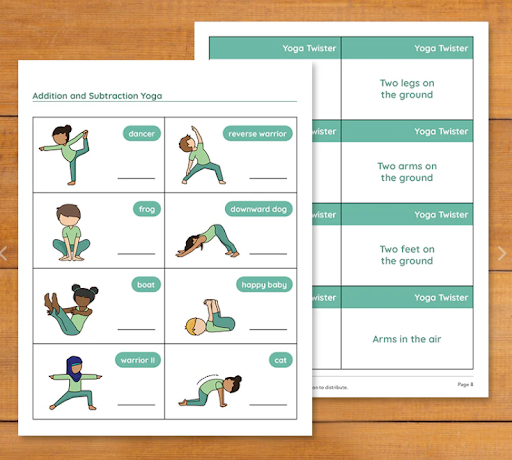
Design a Semester of Kid’s Yoga Classes for Under $50
by Kane SEO November 13, 2024 5 min read
How to Plan an Engaging, Fun, and Memorable Yoga Experience on a Budget
Teaching kids yoga doesn’t have to be an expensive or overwhelming endeavor. With thoughtful planning, creativity, and a bit of resourcefulness, you can design a semester of yoga classes that are engaging, educational, and enjoyable for children—all while staying within a $50 budget. Below, we’ll walk you through key steps to help you organize a semester of yoga classes that are full of mindfulness, movement, and fun, without breaking the bank.
1: Generate a Few Themes or Main Ideas
Before diving into lesson plans and materials, it’s important to decide on the central theme or focus of your kids' yoga semester. Themes give structure and consistency to your classes, and they make learning more engaging for children. Here are some ideas to get you started:
- Seasonal or Holiday Themes: Incorporate elements from the changing seasons or upcoming holidays into your lessons. For example, a “Springtime Yoga” class might focus on blossoming flowers, growing plants, and the animals that come out in spring. A “Winter Wonderland” theme might incorporate snowflakes, animals in hibernation, or winter sports.
- Growth Mindset: Teach children about perseverance, resilience, and positive thinking throughkids yoga poses that represent strength, flexibility, and calm. This can be especially powerful if you're teaching children with a specific need for mindset work (such as those who might struggle with frustration or self-doubt).
- Yoga Poses as Animal Adventures: Kids love animals! Turn each yoga pose into an animal or nature adventure—such as the “cat-cow” pose, “downward dog,” “lion’s breath,” and “butterfly” stretches. This theme helps children connect with animals, nature, and their own bodies in a fun, imaginative way.
- Creating a Personal Practice: Teach children about mindfulness, breathing, and how to find balance both on and off the mat. Emphasize that yoga is not just about the poses but also about creating a personal practice of self-awareness and respect for oneself and others.
- The Power of Breath: Explore different breathing techniques throughout the semester, helping kids understand how mindful breathing can be calming, energizing, or centering. This is a great theme to develop emotional regulation skills in younger children.
Once you’ve chosen your theme, be sure to weave it into your class activities, from poses to songs, stories, and crafts. This will make each class feel connected and meaningful for the kids.
2: Find Resources to Support Your Teaching
To keep your costs low while still providing an enriching experience for your students, you'll want to leverage a variety of free or inexpensive resources. The internet is brimming with helpful materials, and your local library is another great place to find inspiration. Here are a few ideas for finding yoga resources that won't break the bank:
- Library Books: Many public libraries offer free access to children’s yoga books that you can borrow for inspiration. Look for books with illustrations or stories that tie into the theme of your classes. Some popular titles might include"I Am Yoga" by Susan Verde or"Yoga Bunny" by Brian Russo. These can also be used to introduce the children to different concepts of yoga in a way that’s fun and approachable.
- Printable Yoga Materials: Search for free or low-cost printable resources online—many teachers and yoga blogs offer printable yoga cards, pose posters, and activity sheets. For example, you can download sets of printable cards that show different kids yoga poses, breathing exercises, and mindfulness activities. These can be laminated for durability and reused throughout the semester.
- Free Online Resources: There are many free blogs, websites, and YouTube channels offering kids’ yoga sequences, mindfulness exercises, and educational activities. Some websites even offer free downloadable lesson plans, themed yoga cards, and interactive games that you can use in your classes. These resources can be the perfect way to supplement your own ideas without the need for expensive materials.
- Unit Plans and Guides: If you prefer a more structured approach, look for affordable lesson plans or unit studies that cover specific aspects of yoga and mindfulness. Many teachers, including those on platforms like Teachers Pay Teachers, offer well-organized, inexpensive lesson plans that are ready to implement. One example is our own comprehensive Yamas and Niyamas 10-lesson plan unit, which offers a complete framework for teaching kids the ethical principles of yoga in a fun and accessible way.
By gathering a mix of free resources and low-cost materials, you’ll be ready to teach a memorable yoga experience without spending more than $50.
3: Create a Lesson Plan Unit
Once you have your theme and resources, it’s time to organize your lesson plans. A structured lesson plan will ensure that each class is well-paced, organized, and enjoyable for the kids. However, creating a new lesson plan every week can quickly become overwhelming. Instead, we recommend creating a unit plan for the semester.
Here’s a simple strategy to make your planning easier:
- Opening and Closing Rituals: Keep the opening and closing of your classes consistent. Begin each class with a short mindfulness practice, a grounding activity like deep breathing, or a gentle warm-up. This helps kids get into the mindset for yoga. End each class with a brief cool-down and relaxation period, such as lying in "corpse pose" (Savasana) and reflecting on what they learned. The predictability of these rituals will create a sense of comfort and stability for the children.
- Middle Section Variety: The middle section of your class should focus on a variety of activities. For example, each week you can introduce a new set of kids yoga poses, breathing exercises, and fun games or crafts that tie into your theme. You don’t need to completely reinvent the wheel each time—rotate the activities week to week, adding new poses or sequences as kids progress.
- Build on Previous Weeks: As the semester goes on, build on what the children have already learned. For instance, you can revisit poses, refine techniques, or explore deeper concepts related to mindfulness and emotional well-being. This helps reinforce their learning while keeping things fresh.
To simplify your planning, you can also purchase ready-to-use lesson plans. Our Yamas and Niyamas 10-lesson plan unit is a great option, offering a complete, easy-to-follow guide for teaching kids about yoga’s ethical principles, all for a low price.
4: Review Your Lesson Plans and Pack Your Bag


Before each class, take a moment to review your lesson plans and double-check your materials list. Make sure you have everything you need for the class—whether it’s yoga mats, printable cards, or simple props like scarves or stuffed animals to enhance your theme.
To make your life even easier, consider packing a bag for each class, pre-organized with the necessary items, so you can quickly grab and go. Having your materials prepared ahead of time will make your teaching experience smoother and less stressful.
Conclusion:
You can teach a wonderful and engaging semester of kids' yoga on a budget—without compromising on the quality of your classes. By selecting a cohesive theme, using free or affordable resources, and planning ahead, you can create a memorable yoga experience that helps children develop mindfulness, flexibility, and emotional resilience.
Remember, you don’t need to spend a fortune to provide a rich and enjoyable yoga experience for your students. Take advantage of free resources, printable materials, and affordable lesson plans, and enjoy the process of teaching yoga to kids in a creative, mindful way. And if you need additional support, our blog offers free downloads and discounted lesson plans to help you stay on track!
Special Offer: As a thank-you to our blog readers, use codeBlogReadersSave for 35% off your next purchase!
Product Recommendations (Amazon Affiliate Links):
Leave a comment
Comments will be approved before showing up.
Also in Kids Yoga Blog

How Social and Emotional Learning and Yoga Help Kids Breathe Through Big Emotions
by Kane SEO April 21, 2025 4 min read

How Social and Emotional Learning and Yoga Help Kids Breathe Through Big Emotions
by Kane SEO April 14, 2025 4 min read
In classrooms and communities around the world, educators and parents alike are placing a growing emphasis onsocial and emotional learning. And for good reason: helping children understand, manage, and express their emotions in healthy ways is just as critical as teaching them to read or do math.

Power of Yoga for Kids: How It Helps Them Grow, Focus, and Thrive
by Kane SEO March 25, 2025 5 min read
In today’s fast-paced world, children are often exposed to stressors from a young age, whether it’s academic pressure, social challenges, or the overwhelming influence of digital devices. This can impact their physical, mental, and emotional well-being.
Ultimate Kids Year of Yoga Bundle
bundlespricey-contentdigital-resourcesearly-childhood-yoga-mindfulnesselementary-yoga-mindfulnesskids-yoga-resourcesmiddle-high-school-yoga-mindfulnessseasonal-yogayoga-cards
Ultimate Kids Year of Yoga Bundle
5 reviews
5.0 / 5.0
(5) 5 total reviews
$45.00
Ultimate Kids Year of Yoga Bundle
5 reviews
5.0 / 5.0
(5) 5 total reviews
$45.00
Kid’s Sun Salutation Yoga Cards
digital-resourcesearly-childhood-yoga-mindfulnesselementary-yoga-mindfulnesskids-yoga-resourcesliteracyunder-15yoga-cards
Kid’s Sun Salutation Yoga Cards
3 reviews
4.33 / 5.0
(3) 3 total reviews
$10.00
Kid’s Sun Salutation Yoga Cards
3 reviews
4.33 / 5.0
(3) 3 total reviews
$10.00
Yamas and Niyamas: Successful Relationships with Self & Others (tweens and teens)
pricey-contentdigital-resourceskids-yoga-resourceslesson-plansmiddle-high-school-yoga-mindfulnessmindfulness
Yamas and Niyamas: Successful Relationships with Self & Others (tweens and teens)
2 reviews
5.0 / 5.0
(2) 2 total reviews
$49.00$55.00
Yamas and Niyamas: Successful Relationships with Self & Others (tweens and teens)
2 reviews
5.0 / 5.0
(2) 2 total reviews
$49.00$55.00
